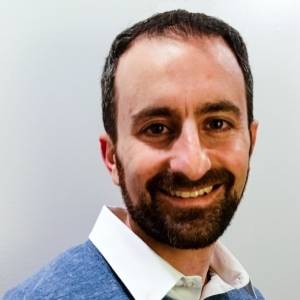Steve W. McLaughlin

Jonathan Rogers

Audio
Audio & Captions
Transcript
[train whistle]
[crowd cheering]
[instrumental Ramblin’ Wreck from Georgia Tech fight song]
Steve McLaughlin: You're listening to The Uncommon Engineer. I'm your host, Steve McLaughlin, dean of the college.
Radio Announcer: We’re just absolutely pleased as punk to have you with us. Please say a few words.
[mechanical whirring]
Radio broadcast: Up in the sky! Look! It’s a bird! It’s a plane!
Steve: Actually, it's a drone. Drone technology is evolving quickly, no longer just delivering packages or pizzas.
Robot: It’s Little Nero, sir. I have your pizza.
Steve: But also helping with search and rescue missions. They’re also certain to crowd the skies in inopportune ways.
I'm Steve McLaughlin, dean of the Georgia Tech College of Engineering, and this is The Uncommon Engineer, our look at how Georgia Tech engineers make a difference in our world, in our daily lives, and in ways you might not expect for an engineer.
My guest today is Dr. Jon Rogers. He's a professor in the Woodruff School of Mechanical Engineering.
Hi, Jon. Welcome to the program.
Jon: Thanks, Steve. Great to be here.
Steve: You know, people are really, really interested in drones and the realization that they're going to have more prevalence in our daily lives. How common do you think drones are going to be in the coming years and where do you see everything headed?
Jon: I agree with you, Steve. There's a lot of excitement out there, and I think if we look at, you know, first of all, I think drones are going to be very prevalent. I think we're gonna see the acceptance of the technology grow steadily over the next several decades. What I think is really fascinating is that a lot of the drone technology that we see today being deployed—it's really executing missions that manned aircraft already do. What's going to be interesting over the next several decades is to watch drones take on missions that manned aircraft have never done, and that's going to be the wave of the future. So you think about on-demand delivery of supplies. You need a box of diapers at your house, and you need it now. You're willing to pay a little bit extra. It can be flown there by an autonomous drone within minutes. And really, that's never going to be achievable by a manned platform, just because there aren't enough delivery people to go around. It's never going to be economically feasible to pay people to do that.
Other things like repetitive missions or on-demand tactical surveillance. You know, a police car shows up at an accident, needs to take an overhead photograph. You're not going to deploy a manned helicopter to go do that. So as soon as you take the person out of the vehicle, it opens up a lot of doors in terms of new missions. So over the next 20 to 30 years, we're going to see these new mission sets opened up, and that's going to come with a lot of regulatory, privacy, liability issues that are going to have to be solved, which is why I don't think drones are going to be performing these missions next year. It's going to take tens of years to get there.
Steve: We're taping the show just a few days after the president of Venezuela was attacked by drones. It was interesting—I follow a number of different cyber-security people online, and there was a prediction made: If you're a famous person or a government official, in five years, I guarantee you will have a cadre of drones protecting you against a cadre of drones that are going to be trying to attack you. It was kind of funny to hear that. But what do you think? I mean, does that make sense?
Jon: It's coming. Drones pose a lot of great opportunities and a lot of—they present possible great benefits—opportunities to benefit our society—but they also present a huge security threat that's very asymmetric. So we don't have the technologies to address that security threat right now, and it's troubling. It's something a lot of people are working on, but I haven't seen any kind of slam-dunk solution yet.
Steve: Privacy is clearly a big thing, whether that's around surveillance, your own personal space. Can you say more about privacy, because it certainly interacts with all this stuff in cyber-security and social media.
Jon: I think privacy is a huge concern. So think about this: One of the issues that arises when you think about drones is this idea of anonymity. So the drone is tele-operated or possibly even autonomous. It's extremely difficult to identify who is operating it, unlike manned aircraft. So if you think about a manned aircraft, you're flying a manned aircraft over a house. There's only a handful of places in the Atlanta area that you can land that aircraft. So if someone's trying to track down who was, you know, who was circling with a video camera over a celebrity's house, it’s actually quite easy to do that with radar tracks and a finite number of airports. Now, you can land a drone anywhere. Radar is, you know, these air traffic radars purposefully don't discriminate and aren't looking for targets that small size, because if they did, they'd see nothing but birds all day. And recently I heard in a suburban Atlanta neighborhood, this drone flew over like a preschool yard and then took video for 10 minutes and then flew off. And the police, they can't find out who did it. And so we have this problem of anonymity when these things are operated. That's going to translate in 20 years, 10 years, whenever to regulations that are going to force manufacturers and are going to force operators to take ownership and remove that anonymity of operation. It's going to basically force drones to interact with cell towers and transmit position signals so that they can be tracked and traced to their operators. Just like a license plate on a car, it's going to have to happen sooner or later.
Steve: Is that kind of tracking absolutely essential or do we really want people to have the ability to be anonymous in these things? And my gut is telling me no, no. As soon as we allow anonymity around these things that are hard to track and we don't know where they're going to take off from or land, yeah. That kind of ability to track and eliminate the anonymity seems really, really, really important thing. I think a lot of people are not really thinking about.
Jon: You have to keep in mind when you fly that drone around, you're not operating in your own private area anymore. Just like when you drive a car on a road, you can no longer—you lose some of your rights to privacy when you operate that aircraft in public airspace. You have to abide by whatever public regulations there are for the public good.
Steve: Some of the things you were saying before, you talked about mission-oriented drones. And I know that you've been working on drones that might lift wounded soldiers from the battlefield and you know kind of more heavy lift kinds of kinds of things. Talk a little bit about that work, what your students are doing, the kinds of things that you're developing.
Jon: So a lot of drones are built for video surveillance. It's really the main roles that they're playing at a commercial level. But there's a lot more potential, as long as you can lift heavier payloads. A lot of the drones that people buy out there are really only capable of lifting a couple of pounds, and you're not going to be able to provide much of a service in terms of delivery. So we've been looking at drones, you know, that can lift heavier payloads, but one of the things you run into is that as the vehicle, as the payload capacity grows, the vehicle size grows significantly. So by the time you're able to pick up 100 pounds, you have one very large vehicle that becomes cumbersome to transport, cumbersome to store, dangerous to operate. So we've been thinking about decomposing that large lifting capability into multiple smaller vehicles that can be scaled, tasked appropriately. You have, you know, a 20-pound box, you need two vehicles. You have a 200-pound box, you need five vehicles. And these vehicles would be kind of all the same and stored in a warehouse and deployed in various numbers as needed. And if you can make them man-portable, the powerful capabilities that for, you know, a defense-oriented mission like, you know, an army-oriented mission, soldiers can keep these drones in their backpacks and take them with them on, you know, on foot. And then when they need to reach out and get supplies, they can pull five of their UAVs together to go get it and bring it back.
If several soldiers—they can pool their drones, deploy them, and send and gather supplies and bring it back together. So this whole idea of collaborative lifting allows you to create this new mission set where you can carry heavy supplies but with smaller vehicles that can be distributed to potentially different people. And the battlefield casualty evacuation is one mission that a lot of people are interested in, because when a soldier is wounded on the battlefield, you know, he or she has to literally be lifted off by someone else. Someone else has to go out there in harm's way, pull this soldier off. So there's a lot of interest in how can we do that autonomously?
Ground vehicles. There's all kinds of issues with them getting tangled and getting blocked or not being able to go up a hill. So air vehicles offer a lot of benefit, but one air vehicle lifting a person presents a huge operational burden, because that's going to be a miniature helicopter. So the vehicles we've developed, three or four of them, they’re relatively small, but they can connect to a person and lift him or her off the battlefield. We think that could be a transformative technology, but there's a lot of technological barriers that we need to overcome and a lot of technology we need to develop. So that's what we're engaged in, some of my students and our research group.
Steve: One of the things that some of our listeners might have heard about, that your work that's received a lot of attention is Tarzan.
Recording of Jon: We designed it like a sloth, but we named it Tarzan. When somebody came to me and asked, how do we get a robot to live in a field for long periods of time and walk around and move around persistently without needing a human to help it, the only way is to do something kind of out of a way and off the ground.
Steve: Tarzan is a robot that you built that swings along like the famed king of the jungle. Say a little bit about the story behind that and more about how you got into that.
Jon: Tarzan was a little bit of a stretch, initially, for our research, because we don't do a lot of ground vehicles or what we call brachiating or swinging robots. We are mostly focused on air vehicles. Some of my collaborators—intellectual, engineering, and computer science—came to me as a mechanical engineer and said, you know, “We want robots to be able to traverse farm fields and perform this persistent surveillance mission and kind of live in fields over long periods of time,” and they had algorithms. They had methods they wanted to use to, you know, sense the plant environment, provide feedback to a grower, et cetera, which was great and they said, “Can you figure out how to have a robot out there all the time? You go work on that for a while.”
And I told them, I said, “Hey, listen, from a mobility standpoint, you've given me the ultimate challenge in robotics and asked me to solve it. You know, there's so much research right now in enabling robots to navigate and locomote in these unstructured environments, you know, not a street, not a sidewalk, but a field full of tangly plants and mud. And this is the hardest environment for our robotic systems to navigate right now.
So we came up with this idea of overhead wires that would hang and basically create a structured environment where a structured environment did not exist previously. We make our own structured environment and then we can traverse that reliably in a very energy-efficient way. So as soon as we hang these wires, presumably low-cost wires over a farm field, we built this robot that not only traverses along a wire but can swing between wires, and that's why we came up with Tarzan. It doesn't just roll along a wire but has to be able to move between wires. And that's the swinging motion that comes in.
Swinging has actually been studied in the robotics community for quite a long time. Can be made very energy efficient and that's the major advantage of it. So we can live out there under solar power for months at a time, swinging its way around.
Steve: Have you built the system?
Jon: Yes, we have and we have a couple versions of Tarzans swinging around the lab. It's a little scary to watch it swing, frankly, because it’s a little bit large and the size is determined by how far crop rows are apart. So you know, they’re typically three feet apart, so Tarzan has to be able to swing three feet, which is kind of a big distance, and that means that Tarzan itself has to be between about four and five feet long when both arms are outstretched.
Steve: The wires that you would string in the field would be one wire per row of crops. But if you chose to do one wire every 10 rows, then Tarzan's get to be a lot bigger? So what kind of sensors is Tarzan sensing? What's Tarzan doing?
Jon: There's a payload on the bottom of it. It's really made to be a flexible sensing platform, but we'll put an infrared camera on the bottom of it and a visual camera. And as we're swinging over these crop rows, we'll take pictures of the plants and process those images using various types of image-recognition, machine-learning algorithms to try to pick out, you know, areas where the plants need more water or they need some type of treatment or so on. And that's of course not my area, but we have collaborators at UGA who are working on systems like that where they can take images of plants and process them in an automated way and provide targeted feedback. Potentially in the future task, another automated system to go out and deploy that treatment. And so there's a difference between, say, a treatment robot that goes out there on a targeted basis once a day and once a week and Tarzan, which is constantly bringing in new pictures. It's out there, it moves kind of slow, but it's always there persistently taking pictures and swinging around these many, many acres by itself with no human intervention.
Its yield improvement is how they measure it. So they say, you know, a certain percentage of our crops every year, they don't grow as well as they should because they needed treatment and we didn't know about it because these farms can be hundreds of thousands of acres. To go target every single plant, right, so that's one area.
What I'm really interested in is moving beyond just crop surveillance to actually harvesting. This is a robot, if you think about a sloth or some other primate, they do the same thing: They swing around the jungle, they hook their tail on a branch, and then they go pick fruit. Why can't Tarzan 10 years from now do the same thing? This is already swinging around. Can we create a separate appendage that harvests. Actually harvesting in the specialty crop community is becoming a big issue, because they can't find people to go pick strawberries. The way Tarzan can not only monitor crops’ health but then tell when a strawberry is ready to pick, go pick it. Now you're talking about something that I think will be even more marketable.
Steve: One of the things that we always talk about on The Uncommon Engineer is your own personal story. What drew you to engineering? Say a little bit about your path to where you are today.
Jon: I like that question because it speaks very much to me personally. I have perhaps a typical story for an aerospace engineer. So if anyone is listening as an aerospace engineer, they probably identify with my story. Ever since I remember, I was obsessed with airplanes. I had every airplane toy. You know, I had the models of the F-14 Tomcat, you know, every different toy model you could build. My toy box when I was a kid had just airplane models overstuffing it, you know, of all different shapes and sizes. Most of them were broken. So I've always loved airplanes.
When I was 16, I took my first flying lesson and solo—did my first solo flight when I was 17 and got my pilot’s license when I was 18. So I've always wanted to work with airplanes and be around airplanes. And when the opportunity came to work, you know, to basically be involved in the aerospace community and create the next generation of aircraft, well how could I turn that down?
For me, I could never be an engineer unless I was passionately driven by the technology. As long as it goes back and connects to my love of aircraft, that's what that's what really keeps me interested at a core level. And so that's why I'm always driven to things that fly. And I always push our research toward experiment, because I want to actually see it fly. That's what excites me.
And on top of that, you're a professor and you're in the classroom and you're obviously completely committed to your research and the technology as you just described. But why a professor? Because you could have gone to work for Boeing, for a company like that. What about being a professor adds on to that?
Jon: It's the creativity. One of the best parts—I always tell my students, the best part about my job is that when we have an idea, I don't really have to ask anyone's permission to go after it. And really, that's the unique part about my job is that, you know, I can scrape together some resources and there's always a pool of interested students to work on stuff. And so these ideas about drones, they collaborate. You know, this idea about Tarzan. These were ideas that I or my collaborators had in an office one day and we turned it into reality. You can't do that anywhere else. When I was a kid, I was always building, you know, I got all the balsa wood and would build different things and modify things. Being able to combine creativity with a love of aviation, well, that's really the core of what my job is all about.
Steve: You're doing so many cool things today. It's hard to imagine cooler stuff out there, but I bet there is out there. So what's next for you and your group?
I think we have a lot of really fascinating research coming up, and I've never been more excited about where we're headed. I really love this idea of modular vertical lifts. I'm hoping that that idea comes together and has an impact. And I think it's so flexible in its application that I can see it going in so many different directions. What we want to do in the next year is we want to get a pack. We've already done many of the experiments that are going to lead up to this, but we're going to come to a culminating experiment in a few years, actually about a year from now, where we put a box in a field, three drones fly to the box autonomously, connect, pick it up, and fly it somewhere. We'll get there soon. And then I think we're going to move from there to looking at picking up people in a lot of these more difficult missions where we're not picking up a box, we’re picking up something that's harder.
I think another fascinating thing that needs to be addressed is this whole idea of counter-UAV, counter-UAS, or counter-drone. You mentioned it before about Venezuela. Well, these are new asymmetric security threats. How do we counter them? I fundamentally believe that we need drones to counter them. So we're developing drones in my lab that go out and capture other drones. I haven’t talked a lot about it, but that's a big topic that we're getting into and we're going to do flight tests on that here in the next year or two. So I'm hoping to make that a big thrust area is, you know, the next generation of drones are going to be able to go out and capture other drones. There's a lot of technological barriers to being able to do that reliably, but that's been one of the areas we're interested in looking at.
Steve: One of the questions we always ask on The Uncommon Engineer is Jon, what makes you an uncommon engineer?
Jon: I think a couple of things. So the first thing I would start with is my love of aviation and my sense of how our work and my students’ work really fits into that unique history of aviation. If you look at technologies that have been developed, whether they’re cellphones, whether they’re internet, the history of aviation is special. You know, the history of aviation is something that is broadly known by the public. They know the Wright brothers. So I look at our research and I like to understand how it fits in the history, how it fits in the emerging technology of aerospace in general. So I'm fascinated by that and I like to place our technologies that we develop into context and make sure that they fit.
But actually, I think the more important answer to that question, what makes me an uncommon engineer, is unlike most engineers, my greatest contribution to engineering will not be technologies. It won't be papers. It won't be even ideas. It will be people. So here in my role, no matter what I do in terms of technologies, the technologies that my students develop after they leave will always be more and will always be better. And so my real goal and my real fulfillment that I get as an engineer is actually when I see other engineers develop and do great things. There's no better feeling in the world—you know this because you've had many students—than having a student come into your office and say, “Hey, I want to work for you in grad school.” And they think they know a lot, but a lot of times they don't really know that much and then they leave your group four or five years later with a Ph.D. My students are usually smarter than me by that time.
Steve: Oh, yeah.
Jon: They're more technically, you know, deep and competent. And you think to yourself, like, wow, that was an amazing transition and it was awesome to be a part of that.
Steve: Again, I couldn't agree with you more. I think we're really, really lucky to be at a university where at the end of the day our job, our careers really are about people. And there's ideas and technologies and other things that come along with that. But we're really, really lucky to have careers that are really truly focused on people.
Jon Rogers, it's really been fantastic to have you here today, hear about all the cool things that you're doing and your personal story. Thanks for everything you do here at Georgia Tech. We're really, really lucky to have you here. Thanks so much, Jon.
Jon: Thanks for having me, Steve. It was great.
Steve: That's all for this episode of The Uncommon Engineer. Join me next month for a conversation about neuroscience, learning, and memory with Annabelle Singer. For now, that's all for The Uncommon Engineer. I'm Steve McLaughlin. Thanks for listening.
[“Ramblin’ Wreck from Georgia Tech”]
Geekout
Audio & Captions
Transcript
[radio dial scanning, static]
[big band swing]
Steve McLaughlin: It sounds incredibly complex—it sounds like—to build these that span—I’m really geeking out here.
[big band music]
[archival recording from Superman] —
>> Up in the sky!
>> It’s a bird!
>> It’s a plane!
>> It’s Superman!
Steve McLaughlin: Why can't I just fly my own drone and just start flying around the neighborhood and maybe fly to the next neighborhood? And then you start thinking of aircraft and, you know, the regulations that you're talking about that need to be in place for all this stuff to kind of work. And it does make sense that that's going to take a long time.
Jon Rogers: So the regulatory piece has not caught up with the technology, and we see that with a lot of emerging technologies. I mean look at what's been going on with Uber with, you know, New York regulating Uber licenses. We've seen that with cyber security, right? You know a lot of new technologies and the regulations aren't out there, social media what have you, drones are another instance of that where this technology is there; it's at people's fingertips. Can you go fly your drone into your neighbor's yard and set up a camera 6 feet off the ground? Well, certainly your neighbor wouldn't like it if you put a camera up on, you know, a tripod on their lawn. But people are flying drones into their neighbor's yards with cameras on them and they look at it differently. The regulations on drones are really just modified versions of manned aircraft regulations and they don't fit—a square peg in a round hole. We need we need people who understand the technology and understand the capabilities, probably to work with all makers to develop laws, and then we also need norms in our society that say, Hey, you know that may not have been against the law, but it was not right.
Steve McLaughlin: As you were talking about the me flying a drone into my neighbor's yard, there's obviously privacy considerations around that. Like you said, you know, in some instances people would view that as a huge privacy invasion.
[archival recording from Superman] —
>> Striding swiftly through the editorial department, Clark Kent steps into an empty storeroom and locks the door behind him.
Steve McLaughlin: I think it's a technical term, but it’s also because we're a Georgia Tech we talk about “swarms.” I think—do you call those swarm robots? You know where it sounds like the technical challenge you're talking about is the collaboration that needs to go on. Let's say there's a wounded soldier and you need three or four or five of these smaller—obviously those drones are talking to each other and need to coordinate. That's the kind of the technical hurdles around that collaboration between the drones?
Jon Rogers: That's certainly part of it. So how do five drones pick up a flexible payload like a person and ensure that they can maintain that stable flight, ensure certain guarantees in terms of stability? This whole idea of cooperative flight control, where they're actually physically manipulating the same object with flexible characteristics, is a very difficult problem, and it's been studied in some very controlled contexts. But when you have something as flexible as a person, it gets very complicated. And a lot of the stability guarantees we've relied on for traditional aerospace community cannot be made anymore.
Steve McLaughlin: You know I can I can imagine for drones picking up a heavy piece of iron or something that's not flexible is pretty easy. But as soon as you have—particularly if you have a patient who's a huge amount of duress, and that adds, that adds an awful lot.
Jon Rogers: We're not going to see it deployed anytime soon because there's still a lot of basic research problems that need to be solved in terms of constraints and how these vehicles fly the vehicle under the constraints of not trying to hurt the patient more than they already are.
[archival recording] —
>> Superman came from another planet, a planet called Krypton just before it exploded in space. A couple of years ago, a piece of the planet came to Earth like a meteor.
Steve McLaughlin: Are those problems that you need to solve, essentially mathematical problems and algorithms and things like devices? Is that the kind of research that you're talking about?
Jon Rogers: Yeah so there's two major areas; one is an algorithm side—so how do the vehicles communicate? What control systems are they running? What sensors do they need and how does that sensor feedback play into the control loop? And that essentially becomes a math problem, detailed complex math problem. And there's various algorithms to solve it. We've looked at bring in machine learning algorithms combining machine algorithms with more classical control algorithms. So we've done work in that area.
The other big area that needs to be investigated are mechanisms. And being a mechanical engineer, at least part of my research in mechanical engineering looking at how these drones actually connect to a person. How can they ensure that they can connect with nobody else to actually go physically connect them? That that connection mechanism has to be extremely reliable. It has to be able to be executed autonomously and disconnected autonomously and also not injure a person.
How does that machine connect to a person without possibly injuring him or her? That's another difficult question.
[archival recording from Superman] —
>> I’ll be on top of the world again—Kryptonite, golden slipper, Eddie.
Steve McLaughlin: An overly-used term—is “interdisciplinary” multidisciplinary? But clearly that's exactly what you were talking about. It’s not just about the math; it's about having students and yourself that have expertise in a broad set. I mean besides mechanical engineers, what are the kind of the skills of someone that would need to develop the kind of thing we're talking about?
Jon Rogers: Yeah. So we need folks—we need folks who know soft robotic mechanisms. So there's a whole class of robotics that deals with soft mechanisms that can interface with the human body without causing harm. There's computer science in machine learning techniques, so people—we need folks who know about Bayesian inference, who know about neural networks to handle that uncertainty that comes from that flexibility of the human. We need people who know about handling qualities of air vehicles so that we can understand, you know, we can understand how to ensure or guarantee stability in a cooperative framework. And we also need multi-agent control folks who know about tasking multi-agent systems and, you know, the ability—we don't have a central planner; we’ll have these vehicles that have to make decisions together.
[archival recording from Superman] —
>> Just mention one word to him—Kryptonite.
Steve McLaughlin: Why would we deploy Tarzan as opposed to drones? But maybe it's that persistence, the fact that the life span of Tarzan as you I think that's kind of where you started—months or years it could be out there entirely on its own. And that's really the advantage over it because clearly drones could probably do some of the same kinds of things. Is that—
Jon Rogers: Absolutely. And a lot of folks have asked us, “Well, what's the benefit over a drone?” And the drone is certainly a capable platform, but the flight times are extremely limited. The ability of someone who doesn't know anything about a robotic system to operate one versus the other is different, right? So, you know, someone who has a large farm, they're going to be more comfortable flying an aircraft or deploying an aircraft around their farm and not knowing anything about aircraft or regulatory issues or putting this relatively cheap robot that just kind of swings along and it makes sense how it works. So we think that that barrier to entry leans a little bit more toward these types of cheap, brake-eating robots.
We're also focused a lot on algorithms, too. So we have a lot of work with partners and we're starting to grow that area of research in what's really called the stochastic optimal control, and it's like a mouthful of technical mumbo jumbo, but really it's about how should autonomous systems make decisions under uncertainty which happens all the time. It's actually been—these decision-making algorithms have been used in the finance community for years in terms of where to sell. But for autonomous vehicles, the autonomous vehicles of the future, they're not going to have Google Maps telling them where to go. They're going to have a vision sensor that’s going to have to figure out what they're looking at. And so they're going to need these control algorithms that say, Hey, I'm uncertain about where I am or what to do, but I still need to make a decision. What's the optimal decision I should make? So we're working on that.
And what I'm seeing is a lot of the ideas that we started in our lab and we worked on them a little bit, they're starting to pay off. Where we—we’re seeing those applications; we're able to push them toward experiment more. And that's been one of the best parts about, you know, moving into this seventh, eighth year my academic career is watching those early investments transition into, you know, actual hardware experiments and technologies and then, also having the students who have that capability and that expertise to make that happen.
[archival recording from Superman] —
>> Now, up with the window. Out and away!
[dramatic organ music]
Steve McLaughlin: You know, one of the things that I see is the barriers dropping between aerospace engineering, mechanical engineering. And all the time we get because, you know, a lot of high school students don't necessarily know what engineers do. And then, but they're good in math and science and so they, you know, gravitate towards engineering and then they have to decide, Should I be an electrical engineer or mechanical engineer or aerospace engineer? What would you say to those students? I know what I say to those students, but I want to hear what you have to say to the students. Does it really—does it matter to those students?
Jon Rogers: Exactly—it doesn't matter. I really don't think it does. I think about the students in my group. So many of my students have been mechanical engineers, and I put them on projects that are made more traditional aerospace engineering. They're smart people; they learn what they need to know. If they have a rock-solid understanding of the fundamentals, you know, they understand calculus, right, and they understand—my students understand circuits; they understand the basics of each discipline which is what we teach here at Georgia Tech the first and the second year, the basics of each discipline. Then the specialized topics, they’ll get a book and they learn it in a month or I work with them one-on-one. And so as we see engineering evolving, these silos are disappearing. What I look for in my group is a really smart person. I was a physics major undergrad, and when I got to grad school, I knew nothing about lift curves, drag curves, wings. I mean, I knew what an airplane did, flown many airplanes, but I didn't really know how it worked. And so I had to spend a few months learning; it wasn't that bad.
Steve McLaughlin: Well, I probably teed you up for that because I couldn't agree with you more because I think, you know, again, for the audience out there that's trying to figure out whether engineering's for them, it is. You know, it doesn't matter as much as it used to because those lines are really, really blurry. And it's just a creative mind and inquisitive mind that has some of these skills. There's just so many incredibly cool things out there. And you're talking about, you know, a thousand a thousand of them.
[archival recording from Superman]—
>> I'm going to find a way to find Superman tonight.
[dramatic organ music]
[marching band music]





